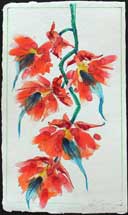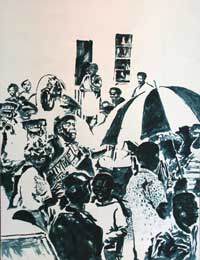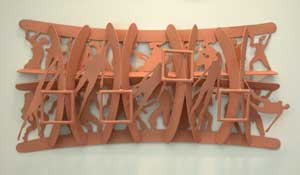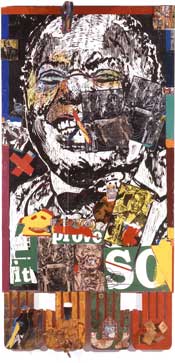John T. Scott: A New Orleans Artist 1940-2007
By Karla Klein Albertson, STYLE CENTURY MAGAZINE

- John T. Scott: A New Orleans Artist 1940-2007
JOHN T. SCOTT was far more than an infinitely creative mind – he was educator, mentor and guiding spirit to New Orleans’s artistic community. Two-thousand-five was a pivotal year for Scott. Works from every stage of his career appeared in a major retrospective, Circle Dance: The Art of John T. Scott, which opened in May of that year at the New Orleans Museum of Art.
The sculpture, paintings, and woodcuts were captured in an accompanying catalog that also included a valuable interview with the artist and an essay on his work. The foreword was written by musician Ellis Marsalis – a friend, occasional collaborator, and one-time colleague at Xavier University – who shared Scott’s faith in the arts as a basis for living.
The show’s title, Circle Dance, comes from the African ring dances seen by travelers such as architect Benjamin Henry Latrobe, who wrote about his visit to New Orleans in the early 19th century. Richard J. Powell, a professor of art and art history at Duke University, wrote in the introductory essay to the catalog: “But ‘circle dance’ also refers to the city of New Orleans itself – a place whose anthropomorphic aspect routinely conjures in the mind’s eye bodies in motion.”
In his own words, Scott often linked his art to its musical counterparts: “What I’ve been attempting to do for the last 40 years, I guess, is to see things with what I describe as ‘jazz thinking,’ and it actually came from listening to musicians … It’s improvisational thinking in the sense that I don’t have to contrive some system of connecting two things that don’t seem related because I understand the relationship.”
Referring to one of Scott’s colorful, asymmetrical wall sculptures, Making Whopee 1986, art historian Powell tried to explain the nature of the cultural fusion Scott achieved: Like the Ray Charles recording of the same title, Scott’s offkilter, chromatically bold, and jazzy creation alluded to roguishness and defied sculptural comportment like Charles’s song mocked Tin Pan Alley sentimentality. Here, as well as in other works from this period, Scott improvised against Euro-America’s artistic debt to the pedestal, and, like the transformation of French high culture into spirited quadrilles, bamboulas, and Mardi Gras in old New Orleans, Scott implanted a rhythmic and decidedly African-American sense of movement into modern sculpture.
Although his work drew on African, African-American, and New Orleans cultural traditions, his fusion of these elements with universal themes allowed him to transcend these roots. This achievement was honored in 1992 when Scott received a “genius” grant from the MacArthur Foundation of $315,000 – the only person in Louisiana to have received this honor.

- Funeral for Louis #2, 2003, acrylic on paper
At the time of his retrospective, John Scott said, “Every artist who has ever made anything, anywhere on the globe, started out with a particular experience of himself/herself. And what changes that idea into art is when that particular can be transformed into a universal concept that anyone can relate to.”
Scott’s method of improvising on a visual theme meant that he created works in clusters that have an internal cohesion – a sculpture series based on the African “diddlie” bow, another called Ritual of Oppression, the Third World Banquetgroup, an Urban Warriorseries of collages. Constantly transforming his style and technique was his characteristic way of working, but can frustrate a collector looking for a “signature” piece.
Arthur Roger owns the New Orleans gallery that represented the artist from the mid-1980s: “I knew John when I first opened my gallery. He was one of the pioneers of the New Orleans art scene. John really wanted to create a community. That was part of the whole goal in teaching [at Xavier University]. He was very close with Ellis Marsalis in the music program.”
In an interview with Style Century Magazine, Roger explained the challenge presented by Scott’s diversity: “John was very plural, he was working on many different things at the same time. You couldn’t comfortably place him anywhere, even from the very beginning. It’s very difficult to handle an artist who works that way. Collectors commonly want to have what they feel is the quintessential piece by an artist – something they can identify. With John, what is that? I still wouldn’t be able to tell you of a piece that would accomplish that.”
John Scott recognized this difficulty and offered a clever counter-argument in his comments for the Circle Dance catalogue:
You know, I think if I walked in a room and I spoke seven languages fluently, people would say that person is brilliant. Yet, if I can speak seven visual languages fluently, critics will say I’m not focused. The way that I work is similar to the way a conductor conducts a symphony. When the guy is conducting, he’s got 50 instruments out there. He can hear them all collectively, and he hears them individually, simultaneously. When I’m in my studio, I may work in calligraphy, printmaking, sculpture, drawing, or whatever else happens to be in there at the time, and I see no conflict in that whatsoever.

- Urban Dense Pack #2, 2005, copper-coated aluminum
No discussion of Scott’s work is complete without a mention of his monumental public sculptures. The geometric Ocean Song (1990) for the Audubon Institute stills stands in Woldenburg Riverfront Park in New Orleans, and the 1994 Spiritgates adorns one side of the New Orleans Museum of Art. Other public commissions can be seen in Philadelphia, Boston, Kansas City and Atlanta.
Shortly after the Circle Dance exhibition closed, the flooding that accompanied Hurricane Katrina in September of 2005 dealt Scott a blow from which he never recovered. His studio in New Orleans East was severely damaged, along with much of his equipment. The Arthur Roger Gallery stepped in to help with the salvage and restoration of many pieces.
Doug MacCash, art critic for the local newspaper, The Times-Picayune, recently told SCM how vulnerable the small industrial area where the studio was located remained in the months after Katrina. He said, “People broke in – apparently searching for scrap metal to sell.”
Even before the storm, Harrah’s Casino had made a major financial commitment to use original works by New Orleans artists in its new hotel in the Central Business District. Two of John Scott’s large scale woodcuts of Louis Armstrong – rescued and restored – now have pride of place in the elegant lobby.
The most unfortunate result of Katrina was that Scott himself was forced to leave his beloved New Orleans. The artist had long suffered from pulmonary fibrosis – possibly an occupational disease – and died on September 1, 2007, far away in Houston.

- So Prove it, 2003, mixed media assemblage
In an article that appeared after the artist’s death, MacCash noted that Scott had longed to return to New Orleans, and expressed those feelings in the months before his death. Scott had told him, “That’s the only home I know. I want my bones to be buried there. I belong there. I need New Orleans more than New Orleans needs me.” Scott was not just an artist but also a major contributor to the local community and an influential educator. In another quote from 2005, he said, “Part of my responsibility is to speak for my community. I want young black kids to realize that, ‘Hey, if that guy’s from the Lower 9th Ward down by Desire and he can do that, then I can do that.'”
John Scott continues to be represented by the Arthur Roger Gallery, which mounted a final exhibition of his works in March 2007. This included a delicate group of flower images, a mixed media on handmade paper that the artist executed after his exile in 2005.
Doug MacCash recalled, “He was very plastic in his art making. He really believed in being able to make art out of anything under any circumstances – that was certainly the proof of it. Sculpture was probably his premier medium that he most consistently practiced, but throughout his career he was always drawing.”
Few pieces of his art have appeared on the secondary market at auction, and his death has certainly encouraged collectors to cherish what they have. A rare exception was the sale this year of Circle Dance, a brightly-painted metal wall sculpture that brought $4,406 at the Neal Auction Co. in New Orleans. The work bore Scott’s monogram, the title, and date 1995, and was accompanied by the original receipt.
After the sale, Neal’s Fine Art expert Claudia Kheel told SCM, “John Scott was such an important artist as well as an influential teacher and mentor in the New Orleans art community. It is tragic that he was not physically able to return to the city after the ravages of Hurricane Katrina. We were privileged to have one of his wall sculptures in our February 23rd and 24th Winter Estates Auction.” A portion of Richard Powell’s catalog essay is an excellent summation of Scott’s impact on the art world: Not only an evocation of New Orleans and its multifaceted culture, Scott’s art somehow rises above Mardi Gras and the sea level, responding to formulae and considerations that have import beyond the specifics of one place, race, or class of people. John T. Scott’s passions – brilliant color, fluid movement, linear poetics, sharp commentary, social justice, among others – are the products of a lifetime of discerning and fashioning: pursuits that, in tandem with one’s personal genealogy, comprise an artistic performance of substantial proportions.
